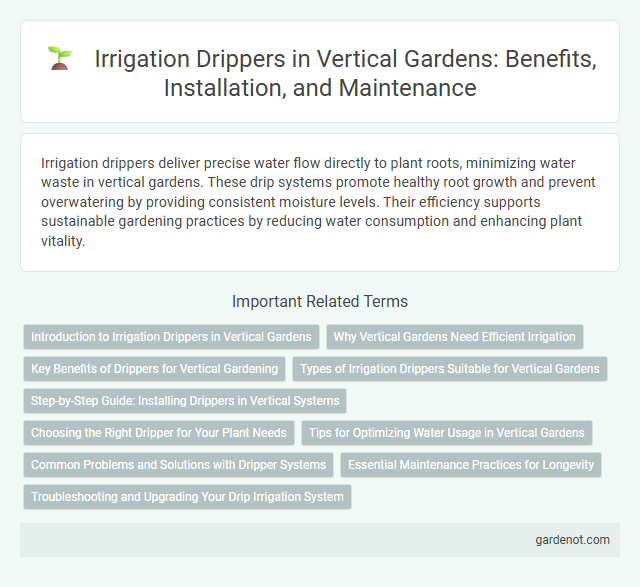Irrigation drippers deliver precise water flow directly to plant roots, minimizing water waste in vertical gardens. These drip systems promote healthy root growth and prevent overwatering by providing consistent moisture levels. Their efficiency supports sustainable gardening practices by reducing water consumption and enhancing plant vitality.
Introduction to Irrigation Drippers in Vertical Gardens
Irrigation drippers are essential components in vertical gardens, delivering precise amounts of water directly to plant roots, minimizing waste and promoting healthy growth. These drip emitters ensure even moisture distribution across various plant species arranged vertically, preventing overwatering and reducing water runoff. Efficient irrigation drippers contribute to sustainable gardening practices by optimizing water usage and maintaining ideal hydration levels in compact, soil-limited environments.
Why Vertical Gardens Need Efficient Irrigation
Efficient irrigation drippers are essential for vertical gardens because they ensure uniform water distribution across all plant levels, preventing overwatering or drought stress. These drippers optimize water usage by delivering precise amounts directly to the root zone, reducing runoff and evaporation. Consistent moisture levels maintained by efficient irrigation promote healthy growth and increase the longevity of vertical garden installations.
Key Benefits of Drippers for Vertical Gardening
Irrigation drippers provide precise water delivery directly to plant roots in vertical gardens, minimizing water waste and promoting healthy root development. These drippers help maintain consistent soil moisture levels, essential for the varied water needs of plants in different vertical layers. Their low-pressure design enhances water efficiency and reduces the risk of overwatering and fungal diseases.
Types of Irrigation Drippers Suitable for Vertical Gardens
Pressure-compensating drippers provide consistent water flow regardless of elevation changes, making them ideal for vertical gardens with varied plant heights. Turbulent flow drippers reduce clogging by preventing sediment buildup, ensuring reliable irrigation in compact green wall systems. Adjustable drippers offer customizable water delivery rates to meet the diverse moisture needs of different plants in vertical garden installations.
Step-by-Step Guide: Installing Drippers in Vertical Systems
Install irrigation drippers in vertical garden systems by first mapping water distribution points aligned with plant placements for uniform hydration. Secure the main water line vertically, attaching drippers at each designated point, ensuring tight connections to prevent leaks. Test the system by running water to check dripper flow and adjust emitters to deliver adequate moisture to all plants.
Choosing the Right Dripper for Your Plant Needs
Selecting the appropriate irrigation dripper is crucial for maintaining a healthy vertical garden, as different plants have varying water requirements. Drippers with adjustable flow rates allow precise control over water delivery, ensuring plants receive optimal hydration without waste. Consider factors such as plant type, root depth, and sunlight exposure to choose drippers that promote efficient moisture distribution and prevent overwatering or drying out.
Tips for Optimizing Water Usage in Vertical Gardens
Irrigation drippers in vertical gardens optimize water usage by delivering precise amounts of water directly to plant roots, reducing wastage and promoting healthy growth. Adjusting dripper flow rates according to plant type and soil moisture ensures efficient hydration without overwatering. Regular maintenance, such as checking for clogs and leaks, maximizes system performance and conserves water in vertical garden setups.
Common Problems and Solutions with Dripper Systems
Irrigation dripper systems in vertical gardens often face clogging issues caused by mineral deposits or debris blocking the emitters, reducing water flow efficiency. Regular maintenance through flushing the system, installing filter screens, and using acid-based cleaners can effectively prevent and resolve these blockages. Ensuring optimal water pressure and selecting drippers with built-in anti-clog technology further enhances system reliability and plant health.
Essential Maintenance Practices for Longevity
Irrigation drippers in vertical gardens require regular maintenance such as flushing with clean water to prevent clogging from mineral deposits and algae growth. Periodic inspection and replacement of worn or damaged drippers ensure consistent water flow and optimal plant health. Using filtration systems and adjusting water pressure can significantly extend the dripper's lifespan and efficiency.
Troubleshooting and Upgrading Your Drip Irrigation System
Troubleshooting your irrigation dripper involves checking for clogs caused by mineral buildup or debris, which can reduce water flow and unevenly hydrate your vertical garden. Upgrading your drip irrigation system with pressure-compensating emitters ensures consistent water distribution across all plants, preventing over- or under-watering. Regular maintenance and the use of water filters can extend the lifespan of your system and optimize plant health in vertical gardens.
Irrigation dripper Infographic

 gardenot.com
gardenot.com